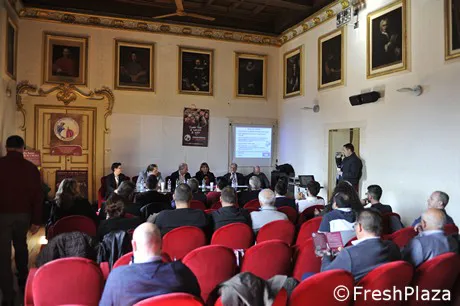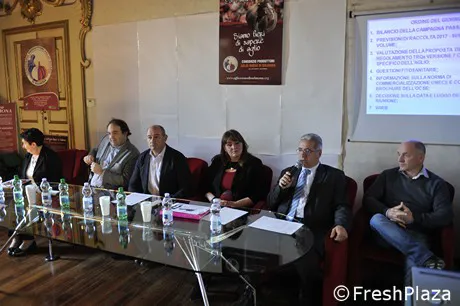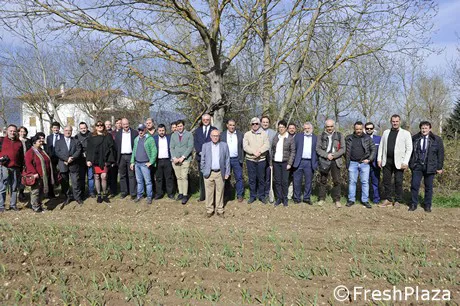Click here for the gallery

The President explained that the Consortium was established in 2010 to safeguard a product that was losing popularity. "There were only 8 producers in the beginning, but now there are 71 growers with 110 hectares in total. Each producer has little over one hectare on average and most of the operations are carried out by hand. Rosso di Sulmona garlic was in trouble, as other more productive red varieties were preferred and prices were not profitable. Over the past few years, more people chose to cultivate this local variety, increasing productivity and creating more jobs."
Click here for the gallery
Francesco Rastelli from Fedagri Confcooperative illustrated the data regarding Italy. "Between 2013 and 2016, we produced 29,500 tons on 3,300 hectares, a 9% increase in production. Market prices at origin for processed garlic have increased - last February, we reached €3.19/kg with an increase of almost one Euro between 2014 and 2016. POs sold produce at an average of €2.31-4.24/kg, with an increase of approximately €0.8/kg."
What is more, Italy went from importing 27 thousand tons in 2013 to the 23 thousands of 2016 (€65 million). Exports also dropped, from 11 thousand tons to 9,185 (€33 to €30 million). A 5-10% increase in production is expected for 2017. In 2016, quality was high, also because of the weather, which helped drying the produce.

The President of the French garlic committee Cristiane Pieters presented the data concerning the 2016 campaign, which was very positive for white, purple and red garlic. Quality was good for white and purple garlic, while the red varieties had fusarium problems. In south-west France, in 2015, crops covered 1,564 hectares, which became 1,713 in 2016. Drome also saw an increase in cultivated areas, which went from 2,660 to 2,750 hectares. In 2015, volumes were 7,300 tons, which became 21,200 in 2016 thanks to the larger yields and crops.
A further increase in cultivated areas is expected for 2017. White garlic prices went from the €2.29 of 2011 to the €3.26/kg of 2016. Purple garlic went from €2.74 to €3.48/kg. Red garlic has a more stable price of €4.77. Retail prices went from €8.34 to €9.44/kg. Foreign garlic, mainly from Spain, went from €8.36 to €8.88/kg. Peeled white garlic sells at €2.80/kg. The increase in cultivated areas in 2017 is 10%. A productivity of 5 tons per hectare is expected for pink garlic and of 8 tons per hectare for white garlic.

Jose Antonio Corell and Julio Bacete talked about Spain. 2016 was a good year, with good yields in terms of both volumes and price. "This was due to the disappointing harvest in China. We took advantage of that. Spain produced over 200 thousand tons on 21 thousand hectares." 150 thousand tons were exported with an average price which went from €1.70 to €2.40/kg. Spain exports garlic all over the world and shipments to South Africa, US, Japan and Taiwan have increased, going from 930 to 1500 thousand tons.
Click here for the gallery
Spain exported 10% less to the EU over the past year (approximately 100 thousand tons). A 5-10% increase in expected for 2017. Spain ended the campaign with no stocks and it might not be able to meet all demands.
After reminding members that the 2018 meeting will be held in France, guests enjoyed a buffet with local products at "Terra Viva".
Contacts
Stefania Baldassarre/Antonio Ricci
Consorzio Aglio rosso di Sulmona
Via Tratturo, 1
67039 Sulmona (L'Aquila)
Cell. 338/5080981
Email: info@agliorossodisulmona.org
Web: www.agliorossodisulmona.org
